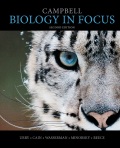
Which of the following respiratory systems is not closely associated with a blood supply?
- A. the lungs of a vertebrate
- B. the gills of a fish
- C. the tracheal system of an insect
- D. the skin of an earthworm
Introduction:
Respiratory system consists of organs that take part in the process of respiration. Respiration is a process, in which food is broken down into simpler components releasing energy. Respiratory system consists of organs that participate in the exchange of gases.
Answer to Problem 1TYU
Correct answer:
The tracheal system of an insect is not associated with a blood supply. Therefore, option (C) is correct.
Explanation of Solution
Reasons for the correct statement:
Tracheal system of an insect consists of spiracles, which is a series of holes or openings. These spiracles are responsible for respiration in insects. Spiracles do not have any blood supply.
Option (C) is given as “the tracheal system of an insect”.
As “the tracheal system is not associated with blood supply”, it is the right answer.
Hence, option (C) is correct.
Reasons for the incorrect statements:
Option (A) is given as “the lungs of a vertebrate”.
The lungs of a vertebrate are connected with blood capillaries. These capillaries bring deoxygenated blood to the lungs and carry away oxygenated blood. So, it is a wrong answer.
Option (B) is given as “the gills of a fish”.
Gills of a fish have gill lamellae and it contains blood within itself. The blood in gill lamellae flows in the opposite direction of the water. So, it is a wrong answer.
Option (D) is given as “the skin of an earthworm”.
Moist skin of earthworm is responsible for respiration and it is associated with blood vessels. So, it is a wrong answer.
Hence, options (A), (B), and (D) are incorrect.
Respiratory systems are those systems, which perform the basic function of respiration. They are somehow related to blood supply either directly or indirectly, but the tracheal system of insects is not associated with blood supply.
Want to see more full solutions like this?
Chapter 34 Solutions
EBK CAMPBELL BIOLOGY IN FOCUS
Additional Science Textbook Solutions
Biological Science (6th Edition)
Chemistry: The Central Science (14th Edition)
The Cosmic Perspective (8th Edition)
Laboratory Manual For Human Anatomy & Physiology
SEELEY'S ANATOMY+PHYSIOLOGY
Biology: Life on Earth with Physiology (11th Edition)
- circle a nucleotide in the imagearrow_forward"One of the symmetry breaking events in mouse gastrulation requires the amplification of Nodal on the side of the embryo opposite to the Anterior Visceral Endoderm (AVE). Describe one way by which Nodal gets amplified in this region." My understanding of this is that there are a few ways nodal is amplified though I'm not sure if this is specifically occurs on the opposite side of the AVE. 1. pronodal cleaved by protease -> active nodal 2. Nodal -> BMP4 -> Wnt-> nodal 3. Nodal-> Nodal, Fox1 binding site 4. BMP4 on outside-> nodal Are all of these occuring opposite to AVE?arrow_forwardIf four babies are born on a given day What is the chance all four will be girls? Use genetics lawsarrow_forward
- Explain each punnet square results (genotypes and probabilities)arrow_forwardGive the terminal regression line equation and R or R2 value: Give the x axis (name and units, if any) of the terminal line: Give the y axis (name and units, if any) of the terminal line: Give the first residual regression line equation and R or R2 value: Give the x axis (name and units, if any) of the first residual line : Give the y axis (name and units, if any) of the first residual line: Give the second residual regression line equation and R or R2 value: Give the x axis (name and units, if any) of the second residual line: Give the y axis (name and units, if any) of the second residual line: a) B1 Solution b) B2 c)hybrid rate constant (λ1) d)hybrid rate constant (λ2) e) ka f) t1/2,absorb g) t1/2, dist h) t1/2, elim i)apparent central compartment volume (V1,app) j) total AUC (short cut method) k) apparent volume of distribution based on AUC (VAUC,app) l)apparent clearance (CLapp) m) absolute bioavailability of oral route (need AUCiv…arrow_forwardYou inject morpholino oligonucleotides that inhibit the translation of follistatin, chordin, and noggin (FCN) at the 1 cell stage of a frog embryo. What is the effect on neurulation in the resulting embryo? Propose an experiment that would rescue an embryo injected with FCN morpholinos.arrow_forward
- Participants will be asked to create a meme regarding a topic relevant to the department of Geography, Geomatics, and Environmental Studies. Prompt: Using an online art style of your choice, please make a meme related to the study of Geography, Environment, or Geomatics.arrow_forwardPlekhg5 functions in bottle cell formation, and Shroom3 functions in neural plate closure, yet the phenotype of injecting mRNA of each into the animal pole of a fertilized egg is very similar. What is the phenotype, and why is the phenotype so similar? Is the phenotype going to be that there is a disruption of the formation of the neural tube for both of these because bottle cell formation is necessary for the neural plate to fold in forming the neural tube and Shroom3 is further needed to close the neural plate? So since both Plekhg5 and Shroom3 are used in forming the neural tube, injecting the mRNA will just lead to neural tube deformity?arrow_forwardWhat are some medical issues or health trends that may have a direct link to the idea of keeping fat out of diets?arrow_forward
 Concepts of BiologyBiologyISBN:9781938168116Author:Samantha Fowler, Rebecca Roush, James WisePublisher:OpenStax College
Concepts of BiologyBiologyISBN:9781938168116Author:Samantha Fowler, Rebecca Roush, James WisePublisher:OpenStax College Biology: The Dynamic Science (MindTap Course List)BiologyISBN:9781305389892Author:Peter J. Russell, Paul E. Hertz, Beverly McMillanPublisher:Cengage LearningBasic Clinical Lab Competencies for Respiratory C...NursingISBN:9781285244662Author:WhitePublisher:Cengage
Biology: The Dynamic Science (MindTap Course List)BiologyISBN:9781305389892Author:Peter J. Russell, Paul E. Hertz, Beverly McMillanPublisher:Cengage LearningBasic Clinical Lab Competencies for Respiratory C...NursingISBN:9781285244662Author:WhitePublisher:Cengage





